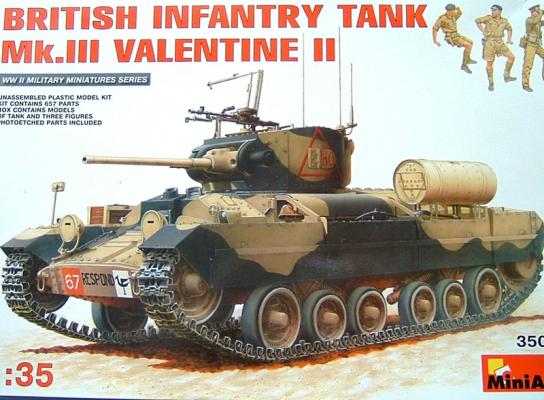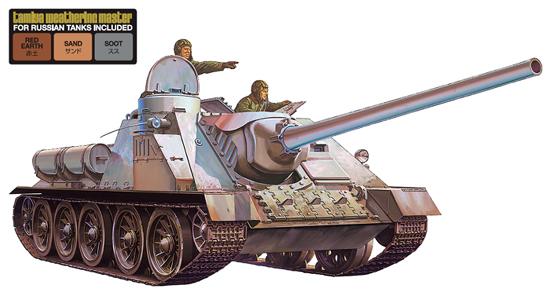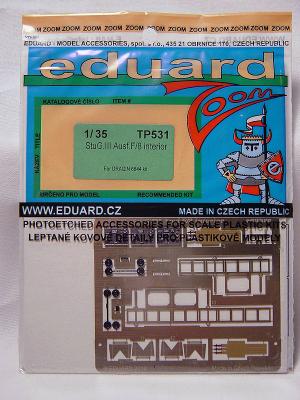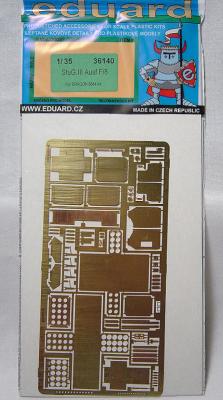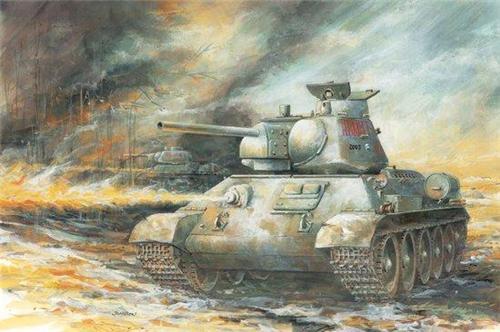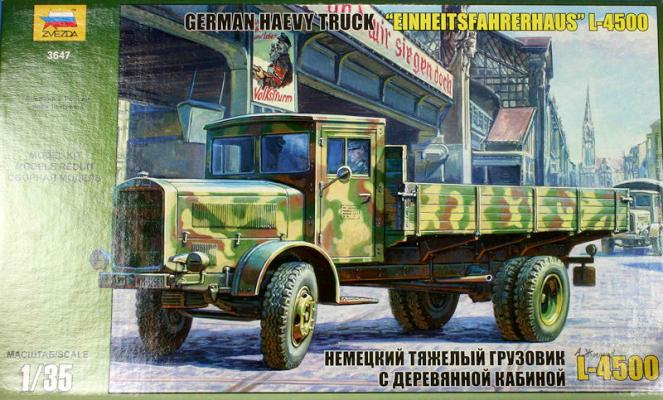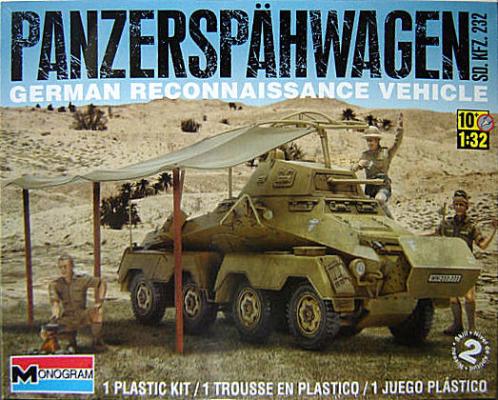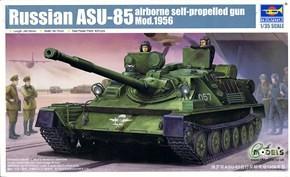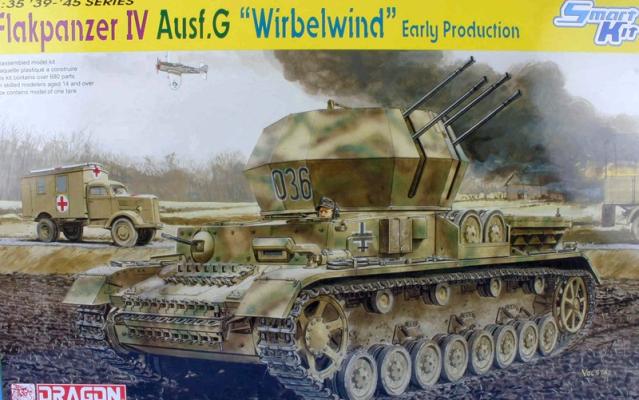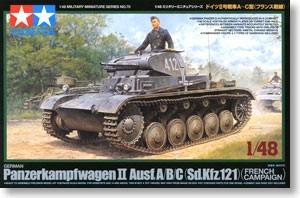Britain's most produced tank during WWII was the Vickers Valentine, representing a full 25% of all tanks built. The Valentine made its combat debut in Operation Crusader in North Africa, 1941 and production ended in 1944 after 8,275 were built. All but 30 of the 1,420 vehicles built in Canada were Lend-Leased to Russia, along with 2,394 of the British built Valentines. It is said that when offered replacements, Russian crews asked to keep their dependable Valentines. No wonder then, that the Ukraine model company, MiniArt, was the first to provide a truly state of the art model kit of the Valentine, with one version kitted specifically as one of the Valentines that served on the Eastern Front. MiniArt has marketed a few variations of the Valentine to capture the subtle differences between them. These are all new tooled models – they are not re-releases of the old Alan, VM or Maquette models. Every serious Armor modeler should have a Valentine in his collection.
This kit is an acknowledged reissue of a kit first issued in 1966. In those days, for you youngsters out there, the big thing was motorized kits, especially armor. Accuracy was not terribly important, as long as it looked cool squeaking its way across the carpet. Usually black, the rubber tracks were stretched around the running gear and off it went. This kit is that kit, minus the stamped metal gear box, motor(s), and wired control box (no RC, kids, just levers and wires).
This kit comes with 12 pieces to upgrade the interior of your StuG.III F/8. The parts replace the 3 Dragon-supplied radio parts with highly detailed color face plates and radio boxes. It also comes with 2 headphones (a very nice addition) that have been pre-painted in black.
Can’t wait to build my StuG.III, the parts are going to look great.
I highly recommend this upgrade kit to all detail nuts like me (but still not a bolt counter).
I would like to thank Eduard and IPMS/USA for the opportunity to conduct this review.
This upgrade PE kit comes with 2 sheets totaling over 100 pieces (part 99 has 12 pieces to it).
The first sheet has parts 1-50. This sheet has most of the ammo box details. You also get a set of mud flap enhancements.
The second sheet, parts 51-100, has most of the small interior enhancements for the tool mounts, mp5 gun mounts, tool and ammo box handles and latches, along with various enhancements such as corner plates and locks (part 92) for the boxes. You even get a set of 4 PE chains (part 55).
You can’t go wrong with this very detailed upgrade kit for your StuG.III F/8. Also see my review for the StuG.III Ausf.F/8 Interior Radio PE set – the two really go well together.
I highly recommend this upgrade kit to all detail lovers.
I would like to thank Eduard and IPMS/USA for the opportunity to conduct this review.
Few weapons on the battlefield can instill fear and panic more readily than the fire-spewing armored flame thrower, especially in the form of a main battle tank. Germany, Britain, and the United States all used this fearsome weapon, and Soviet Russia was no exception. Very useful for breaking trench lines and reducing bunkers and machine gun nests, the OT-34 was used in several variants throughout the war. This version is based on the 1943 version of the T-34, with a raised commander’s cupola. The turret casting molds were not uniform from one factory to the next, giving rise to many subtle variations in shape and texture.
The L-4500 German Heavy Truck was a design caused by the shortage of metals during 1943. To reduce the amount of metal used in fabrication, the following design changes were made: the front fenders were made of sheet metal, the cabin was made of plywood on a wooden frame, and the front and rear bumpers were eliminated. These modifications stayed in production through the end of the war.
Step 1- 6. These steps direct the building of the engine. Even if you do not plan to open the hood to show the engine, you will need to at least include the main body along with parts C41 and C27 (lower pan), as it and the drive shaft that attaches to it are visible from the side. If you intend to use the mechanic figure as part of a diorama and show the hood open, you will need to do surgery to open the hood and finish the engine.
The Panzerspahwagen Sd. Kfz. 232 was one of many various types of vehicles with eight-wheel drive and eight-wheel steering used by armored reconnaissance units of the Wehrmacht and Waffen-SS. These armored vehicles were used in many campaigns in Africa and Europe during World War 2. The Sd. Kfz. 232 was noted for its medium range wireless set and frame antenna. This type of antenna was used until 1942 when it was replaced by a single pole antenna. Sd. Kfz. 232s were usually armed with a 2cm KwK 30 L/55 auto cannon capable of firing at a rate of 280 rounds a minute and a 7.92mm machine gun, both mounted in a single turret. A crew of four was typical. The commander and gunner sat in the turret, the driver sat at the front, and a secondary driver was emplaced in the rear of the hull. Powered by a 155 hp 8-cyl gasoline engine with a range of 186 miles and a top speed of 53 mph, it is easy to see why it was one of Rommel’s best long-range recon vehicles.
Short History
Soviet Airborne Forces used the ASU-85 in airborne operations during the Cold War Era. Its primary role was light infantry support or assault, with limited anti-tank capability. The ASU-85 replaced the open-topped ASU-57 in service. It weighs approximately 13,780kg or 13.78 tons and has a very low silhouette of just 2,1 meters. It is powered by one V-6 six-in-line water-cooled diesel engine with 240hp. It was designed on the PT-76 tank chassis, but lost its amphibious capabilities. Armament consists of an SD-44 85mm gun carrying 40 rounds (4 rounds per minute) and one 7.62mm PKT co-axial machinegun. Effective range is around 260km (162 miles), and armor protection is up to 40mm. The vehicle was NBC-sealed and equipped with IR-sights for night fighting.
The Flakpanzer IV “Wirbelwind” (German for whirlwind) was a self-propelled quad 2.0 cm anti-aircraft gun based on the Pz IV. It was developed in 1944 as a replacement for the Mobelwagen. The Wirbelwind was replaced by the Ostwind with a single 3.7cm FlaK 43. The number of units produced ranged from upper 80’s to approximately 105.
This is a multimedia kit comprised of 500+ styrene parts, magic tracks, one braided metal wire (which is very stiff even after annealing), one photo etched fret, decals and the set of instructions that need to be reviewed very carefully before gluing any parts together.
Most Dragon models today are a collection of old sprues and new sprues added to create a new kit variant. In this case, Dragon has done so and you will have some sprues with the same letter. Even though Dragon has not advertised this is a 2-in-1 kit, you have many options that need to be reviewed and decided on before you start this kit.
The Panzerkampfwagen II, or Pzkfw. II for short, was a light tank produced as a stop gap measure by the German armaments industry for the German Armed Forces prior to and during the early stages of WW2. What the German High Command really wanted was the more powerfully armed Panzer III and Panzer IV tanks, but German industry found producing the more complex heavier tanks in any meaningful numbers beyond their capacity, at least initially. That said the Pzkfw. II series of light tanks went on to serve with distinction during the initial phases of the War, especially in the Polish and French Campaigns of 1939 and 1940, with nearly 1,900 vehicles of all marks eventually seeing production.

